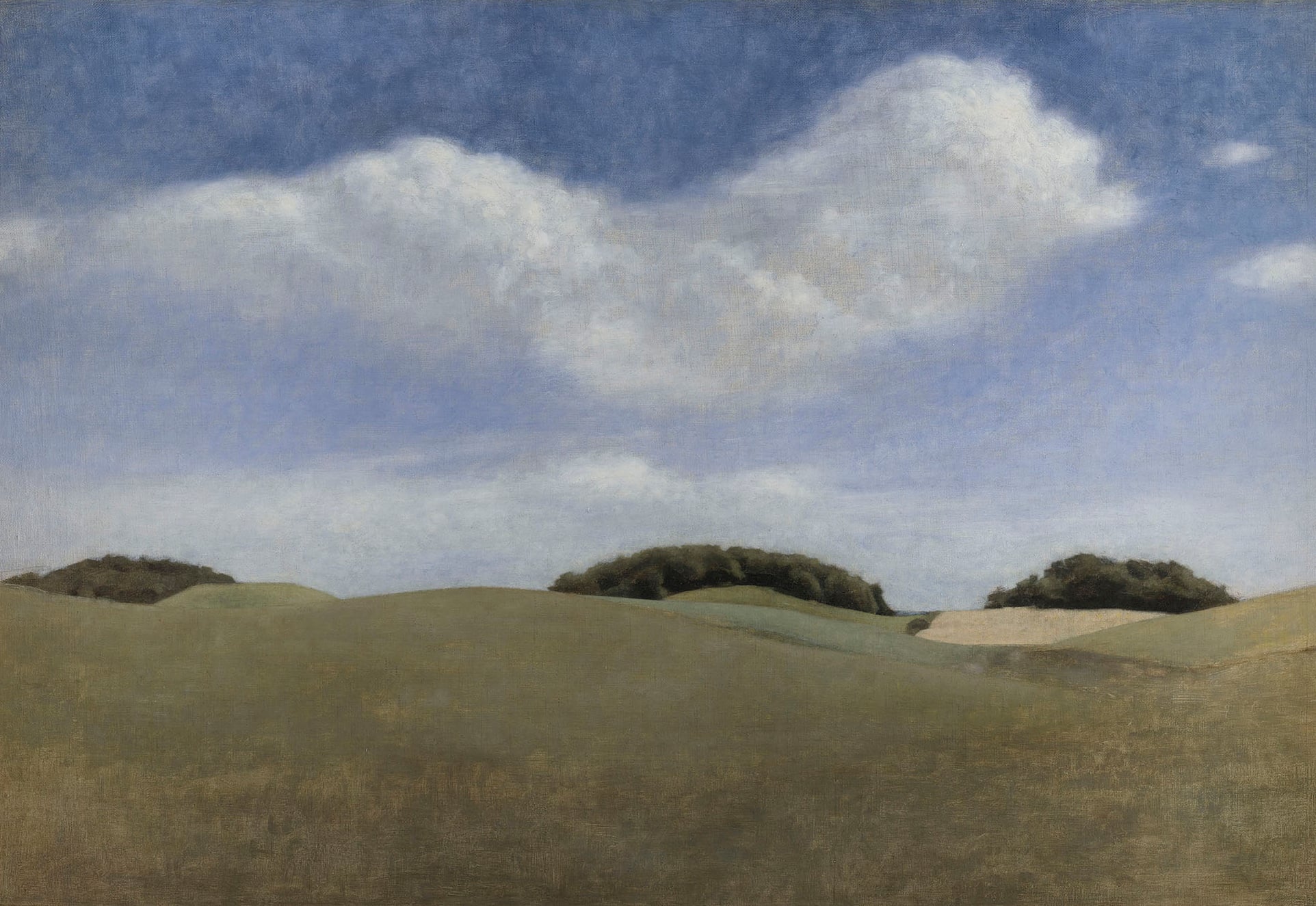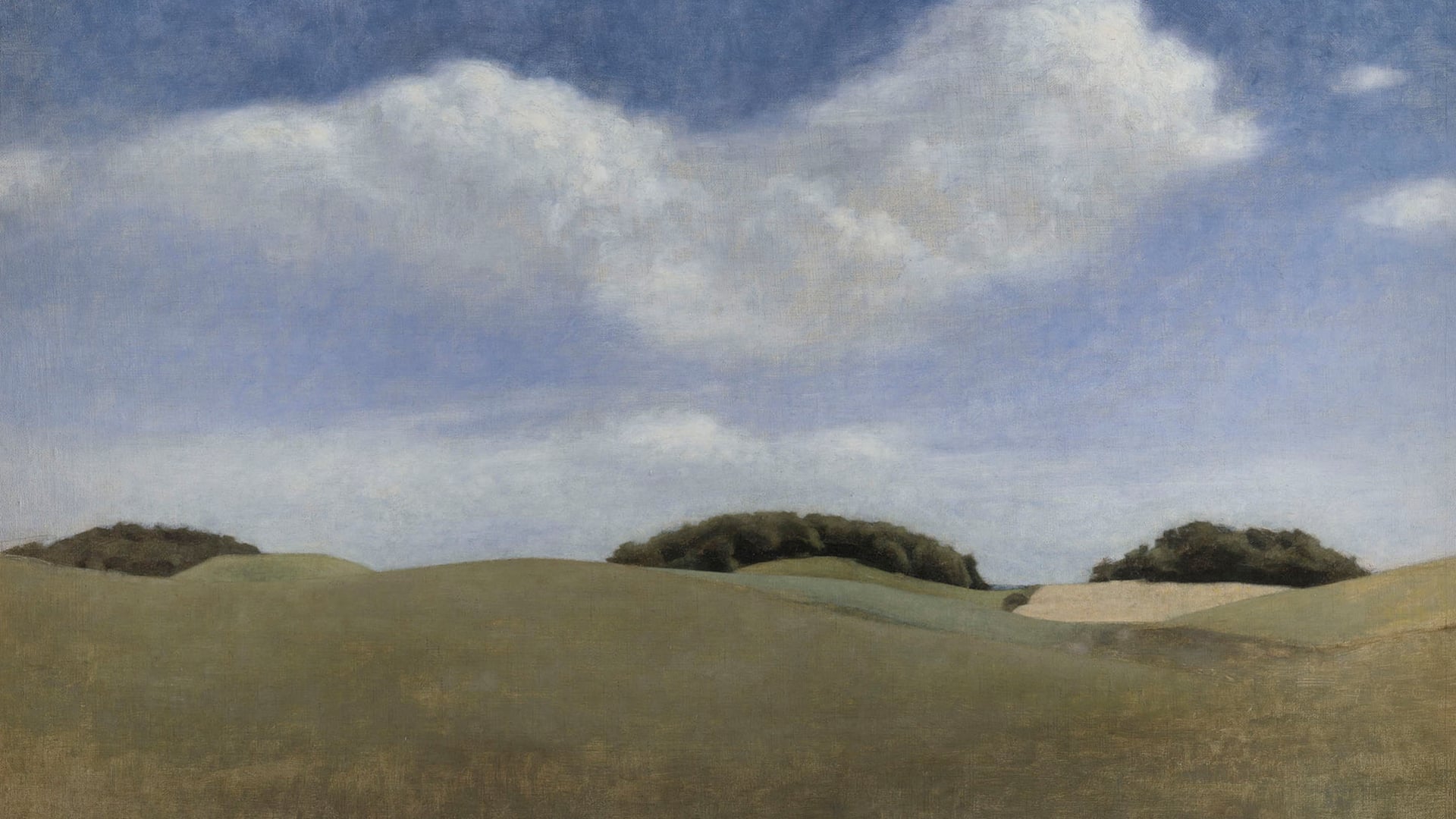

Acquired from the artist by Aage Bramsen (1855-1921), Copenhagen.
By family descent to 2024,
Acquired from the above.
By family descent to 2024,
Acquired from the above.
Sophus Michaëlis and Alfred Bramsen, Vilhelm Hammershøi. Kunstneren og hans værk, Copenhagen and Kristiania, 1918, no. 279, p. 104.
Vad, Poul. Vilhelm Hammershøi and Danish Art at the Turn of the Century, Yale Univeristy Press, 1992.
Kramër, Felix et al. Hammerhsøi, Royal Academy of Arts, 2008.
Monrad, Kasper. Hammershøi and Europe, Statens Museum for Kunst, 2012
Kramër, Felix et al. Hammerhsøi, Royal Academy of Arts, 2008.
Monrad, Kasper. Hammershøi and Europe, Statens Museum for Kunst, 2012
"These pictures are intensely Danish. Each one is a penetratingly seen portrait of a typical Danish landscape, of typical Danish light and weather"
Vilhelm Hammershøi was a Danish artist known for his timeless, enigmatic interiors and landscapes. Through meticulous observation, his work stood out during a period of artistic experimentation. By denying his scenes the power of movement and sound, his work echoes a kind of stillness that conveys a degree of loneliness. His sparse landscape scenes evoke both a haunting beauty and a meditative tranquillity. By showing a great sensitivity to both light and spatial construction, Hammershøi captured the subtle interplay of light and shadow, enhancing the ethereal quality of his compositions. His use of a subdued palette further emphasises this, allowing for more engagement with the psychological and emotional layers of each scene. By crafting a world of introspection and subtle emotion, he has secured his place as a distinctive figure in the world of Danish & European Symbolism.
Painted in 1905 and pared down almost to abstraction through layered planes, Landscape, view from Lejre bears witness to Hammershøi's ongoing - and lesser known - fascination for landscape painting. The view is from the village of Lejre west of Copenhagen, not far from the coast. The strata of sky, dune, and prairie border on the abstract, putting Hammershøi ahead of his time. As in his interiors, Hammershøi creates a hermetically sealed world, denying the viewer almost every frame of reference to the wider world beyond a tantalising glimpse of the sea on the horizon. The present work relates to the smaller version in Stockholm’s Nationalmuseum.
The construction of the composition is deceptively complex, with careful attention paid to the subtle gradation of tone and manipulation of scale. A letter from the artist’s brother Svend to Anna Hammershøi in 1896 details how Vilhelm would often start a landscape composition en plein air, often in pencil. The inspiration for these panoramic landscapes may have been Johan Thomas Lundbye. Hammershøi owned a work by Lundbye, and his first instructors, Vilhelm Kyhn and Frederik Rohde, were landscape painters in the Romantic sense. Indeed, no doubt Hammershøi also took inspiration from the German Romantic painters, notably Caspar David Friedrich.
Landscape, view from Lejre is much akin to the landscapes of the Danish Golden Age. Lundbye’s portrayals of Zealand landscapes with their extended lines beneath a single stationary cloud, exhibits the extraordinary relationship between the sky and landscape. Their white colour makes the iridescent blue of the sky ring audibly, much in the same way as the Danish master of light, Christen Købke.
Hammershøi creates the experience of unascendable distance, emphasised by the high, rolling terrain which rises up in the foreground and only allows the eye sporadic access to the hills behind. In a departure from the Golden Age, Hammershøi eliminates linear perspective; the landscape continues beyond the frame and, with its seriality, seems to continue forever. We only see a small part of a much larger world. Hammershøi abandons historical context and romanticised and idealised depictions popularised in the Golden Age of painting. His landscapes are beautifully fragmented and deconstructed, exuding a tone of emptiness and the unfamiliar. They are silent, absent of any indication of human existence and “defy our sense of scale, time and space”.
Vilhelm Hammershøi was a Danish artist known for his timeless, enigmatic interiors and landscapes. Through meticulous observation, his work stood out during a period of artistic experimentation. By denying his scenes the power of movement and sound, his work echoes a kind of stillness that conveys a degree of loneliness. His sparse landscape scenes evoke both a haunting beauty and a meditative tranquillity. By showing a great sensitivity to both light and spatial construction, Hammershøi captured the subtle interplay of light and shadow, enhancing the ethereal quality of his compositions. His use of a subdued palette further emphasises this, allowing for more engagement with the psychological and emotional layers of each scene. By crafting a world of introspection and subtle emotion, he has secured his place as a distinctive figure in the world of Danish & European Symbolism.
Painted in 1905 and pared down almost to abstraction through layered planes, Landscape, view from Lejre bears witness to Hammershøi's ongoing - and lesser known - fascination for landscape painting. The view is from the village of Lejre west of Copenhagen, not far from the coast. The strata of sky, dune, and prairie border on the abstract, putting Hammershøi ahead of his time. As in his interiors, Hammershøi creates a hermetically sealed world, denying the viewer almost every frame of reference to the wider world beyond a tantalising glimpse of the sea on the horizon. The present work relates to the smaller version in Stockholm’s Nationalmuseum.
The construction of the composition is deceptively complex, with careful attention paid to the subtle gradation of tone and manipulation of scale. A letter from the artist’s brother Svend to Anna Hammershøi in 1896 details how Vilhelm would often start a landscape composition en plein air, often in pencil. The inspiration for these panoramic landscapes may have been Johan Thomas Lundbye. Hammershøi owned a work by Lundbye, and his first instructors, Vilhelm Kyhn and Frederik Rohde, were landscape painters in the Romantic sense. Indeed, no doubt Hammershøi also took inspiration from the German Romantic painters, notably Caspar David Friedrich.
Landscape, view from Lejre is much akin to the landscapes of the Danish Golden Age. Lundbye’s portrayals of Zealand landscapes with their extended lines beneath a single stationary cloud, exhibits the extraordinary relationship between the sky and landscape. Their white colour makes the iridescent blue of the sky ring audibly, much in the same way as the Danish master of light, Christen Købke.
Hammershøi creates the experience of unascendable distance, emphasised by the high, rolling terrain which rises up in the foreground and only allows the eye sporadic access to the hills behind. In a departure from the Golden Age, Hammershøi eliminates linear perspective; the landscape continues beyond the frame and, with its seriality, seems to continue forever. We only see a small part of a much larger world. Hammershøi abandons historical context and romanticised and idealised depictions popularised in the Golden Age of painting. His landscapes are beautifully fragmented and deconstructed, exuding a tone of emptiness and the unfamiliar. They are silent, absent of any indication of human existence and “defy our sense of scale, time and space”.